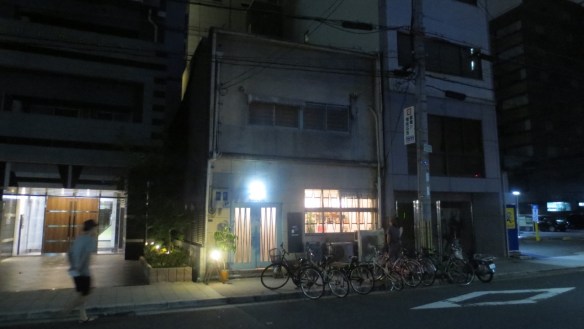With half a day free while visiting relatives in Osaka, I had an opportunity to start looking into the sound scene here. This ever-so-slight beginning will be supplemented by future visits, to develop an understanding of this city’s sonic culture. This post is a starting point from which to look into the infrastructure that exists in Osaka for practices connected with sound, including the venues, artforms, and producers involved.

With such little time available, I was doubtful that I would be able to catch any actual events, but I was fortunate that the venue HOPKEN had three bands playing the first night I had free. While certainly not my kind of music, nor particularly experimental, it was at least an opportunity to see the venue and how it worked. HOPKEN is pretty central in Osaka, an unassuming two-storey building nestled in amongst the office blocks and nearby a major elevated expressway. Inside it has a variety of spaces, from the bar that you walk into from the street, a small art gallery space downstairs in the basement, and upstairs the performing space, where books and music releases were also on display and for sale. I walked in halfway through the first act, “friendly hearts of Japan”, a laconic new wave-style band, quite tight and skilled in their playing, but a bit lackluster in their delivery, very indie. The second band was made up of a double bass player, piano, and vocals performing jazzy numbers that I found too saccharine in their delivery and formulaic in their structure, although the band seemed to have a good rapport between themselves and with their appreciative audience. After politely sitting through their set, I decided to cut my losses and leave. As I walked out onto the street a member of “Hi,how are you?”, the band who were playing next, asked me if the previous band had finished. He was interested to know what I thought about the gig, and I had to be honest with him that I wasn’t really a big fan of what I had heard so far. He told me that his band performed songs which were influenced by the British rock band Queen, which didn’t really change my mind about my decision to leave. My loss, I’m sure.

The following morning I had a few hours available, so I got up early and travelled to the north of Osaka, to a picturesque little alleyway where synth designer Tetsuji Masuda has his workshop. Tetsuji produces custom-made synths under the brand name JMT Synth, which are used by experimental musicians in Japan and abroad. I’m not terribly knowledgeable about the technology or practice of synths, I’m also a bit wary of the fetishisation of technology that synths seem to have come to embody, but some of Tetsuji’s creations were really quite fascinating, especially the half-dome pieces that he had hanging on the wall of the cafe/bar that he and his partner Tomoe Inoue (also an experimental musician) run on the ground floor of the building. The point where these instruments become aesthetic objects, and express in their forms the gestural performance necessary to play them could be quite interesting.





My issues with synths aside, Tetsuji and I had a very enjoyable conversation over coffee about his designs and their fabrication. Tetsuji is keen to visit China, so I tried to give him a balanced view of the situation there – perhaps someone could invite him over?
After that I hastily caught the subway down to the deep south of Osaka city, into the suburbs on the border between Osaka and Sakai cities, to visit a tiny bar/event space called Bar Kitty, run by Kaori Dohgase and her husband Snoo. This has all the features of an archetypal alternative space, its multiple functions packed into a single long, thin room, stuffed with ephemera related to their events, a bar and cooking range along one side, and a small raised platform at the end which could accommodate only two or three performers at most. In terms of audience, there is only room for around 20 people in the space – it’s very intimate! I was starving by now, having skipped breakfast, so while Snoo cooked up some tasty Yakitori Soba for lunch we chatted about their space and activities, and their relationship with the local area they exist within. They have regular weekend events with rap, noise, and experimental performances. Bar Kitty seems to be great little local hangout, providing an important home base for artists outside of the mainstream.






Many thanks to Yan Jun, Michael Eddy, Go Tsushima, and Aki Nagasaka for helping make the connections in Osaka, and to my sister- and brother-in-law for putting up with me.


You must be logged in to post a comment.